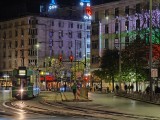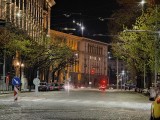Xiaomi 13 Ultra review

Low-light photo quality
As is the norm, the Xiaomi 13 Ultra applies some level of Night mode processing automatically when it deems it necessary. It's a toggle you can switch off in settings in case you prefer having full control over the process, though the results you'd get with no computational magic will likely discourage you from doing so.
Main camera
Anyway, starting with full Auto operation (Photo mode, Auto Night mode enabled), the 13 Ultra's main camera shots at night are superb. Exposures are well balanced, achieving excellent development at both tonal extremes, without making for an artificially brightened look.
Colors maintain accuracy and saturation, and there are no white balance blunders to speak of. Detail remains rendered naturally, as opposed to the broader strokes of heavy sharpening that can be observed on some other phones.











Low-light samples, main camera (1x), Auto Night mode
The dedicated Night mode brings marginal improvements that we're often not even sure if they're down to the different mode or simply shot to shot variation depending on how stable your hands were while shooting that particular frame. Still, we could convince ourselves that there's slightly better definition in the shadows, at least in some scenes, and there's more aggressive highlight retention going on.
There's also the matter that some scenes may simply be too well lit for any Auto Night mode to kick in, so forcing it will result in a different photo than the one from full Auto - like the fire hydrant pair of samples.
Overall however, it's a matter of splitting hairs, and the full Auto is perfectly good enough - being properly great, of course.











Low-light samples, main camera (1x), Night mode
Mind you, by 'full Auto' we mean leaving the Auto Night mode toggle On in Photo mode. Switch that off, and dynamic range will take a hit - in contrasty scenes, you'll be looking at blown-out light sources and areas of pitch blackness.








Low-light samples, main camera (1x), Auto Night mode OFF
Starting our way up the zoom range, the 2x level does not have a dedicated Night mode, but the Auto NM does appear to be working when you're in Photo mode since it does a better job with highlight and shadow development than what you'd get if you turn it off. The results are very good overall, even if 1:1 examination does reveal pixel-level detail isn't quite up to the high standard of the 1x shots.




Low-light samples, main camera (2x), Auto Night mode




Low-light samples, main camera (2x), Auto Night mode OFF
3.2x telephoto camera
At the 3.2x zoom level, it's a bit more of the same - harsh shadows and highlights with no Night mode action, and subtle differences between full Auto and Night mode, but overall great performance in terms of exposure and dynamic range. Detail is very good, noise is well controlled, too.
It's at this zoom level that we're becoming more aware of the Ultra's tendency to bleach scenes with a particular type of lighting - like the first one below, which is notably warmer and more yellowish in reality than its rendition from the 3.2x zoom camera. The main camera showed some signs of that, and it got more pronounced at 2x, but it's especially evident here. That anomaly aside, we don't have grounds for complaint.








Low-light samples, telephoto camera (3.2x), Auto Night mode








Low-light samples, telephoto camera (3.2x), Night mode






Low-light samples, telephoto camera (3.2x), Auto Night mode OFF
5x telephoto camera
We got a bit more of that loss of color/warmth out of the 5x telephoto camera - again, it's not in all scenes, but we did catch an extra one with the 5x (the fourth sample below) in addition to the cathedral from the first scene. In other scenes, we did get properly saturated and accurate colors, so apparently, it's only certain types of subject/light combos that fool the Ultra's algorithms.
Another deficiency of this camera in low light is its rather strong astigmatism- the streaks of light spilling from what should be point light sources shining into the camera. These appear unavoidable.
The 5x telephoto does capture good detail once again, even if things are a little softer than ideal.








Low-light samples, telephoto camera (5x), Auto Night mode






Low-light samples, telephoto camera (5x), Night mode






Low-light samples, telephoto camera (5x), Auto Night mode OFF
Ultrawide camera
We don't have quite as much to complain about on the ultrawide - it's a solid performer. We're getting great dynamic range - a fact made all the more impressive by its extreme field of view which inevitably gets all sorts of extreme shadows and highlights in a single frame. It was also more dependable in terms of white balance than the telephotos and produced accurate results across all scenes.
We're also happy to report that while the 13 Ultra uses a smaller sensor for its ultrawide than the 12S Ultra (and 11 Ultra), there's no appreciable drop in photo quality in the dark - detail is as good as before, which is very good. That said, we can't help but wonder what would have happened if Xiaomi had used the larger sensor again (or another, newer, but as large).








Low-light samples, ultrawide camera (0.5x), Auto Night mode








Low-light samples, ultrawide camera (0.5x), Night mode








Low-light samples, ultrawide camera (0.5x), Auto Night mode OFF
Once you're done with the real-world samples, head over to our Photo compare tool to see how the Xiaomi 13 Ultra stacks up against the competition.



Xiaomi 13 Ultra against the Oppo Find X6 Pro and the vivo X90 Pro in our Photo compare tool
Reader comments
- Aku
- 15 May 2024
- tZ0
Go custom dude.. So. Easy
- Jagganatha
- 03 Jan 2024
- 0F1
The 50Mp option for the still pictures is, as seen here, very good. I am hoping you post corrected samples from the RAW file options, and information about the Raw files qualities themselves as there are phones that in software edits appear devoid of...
- ILFforever
- 26 Dec 2023
- YQu
I believe there's a setting for it in camera>Audio settings>Smart noise reduction.